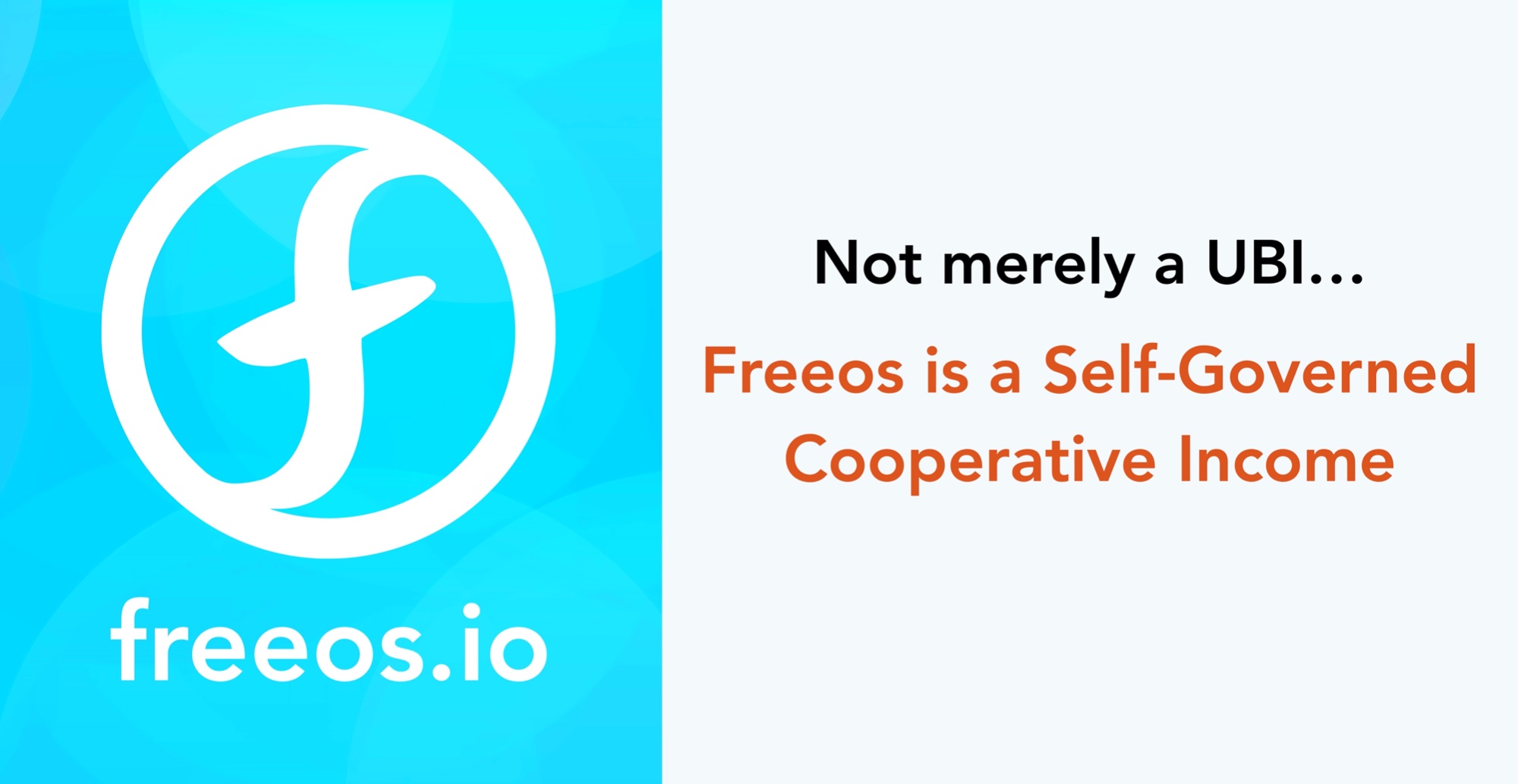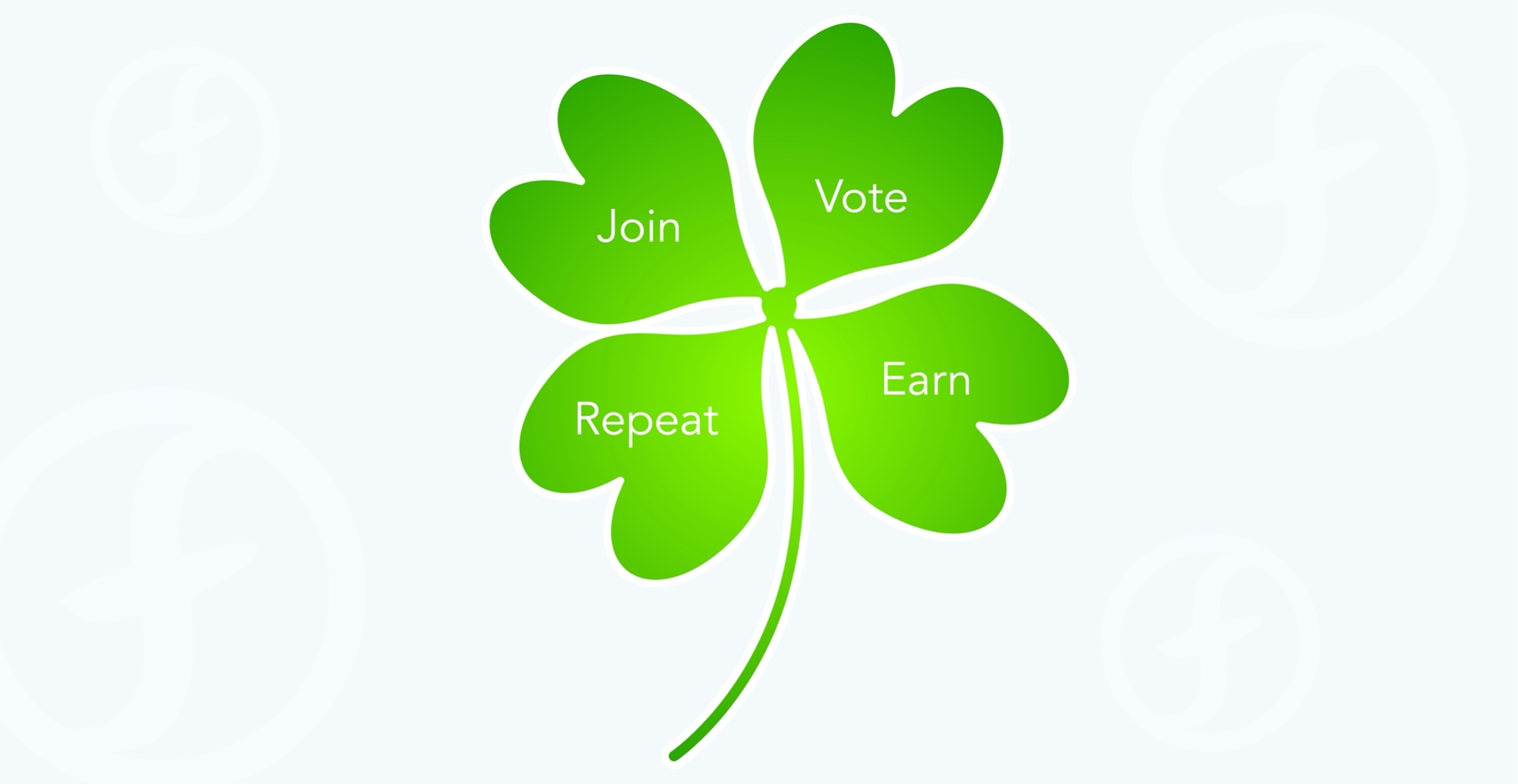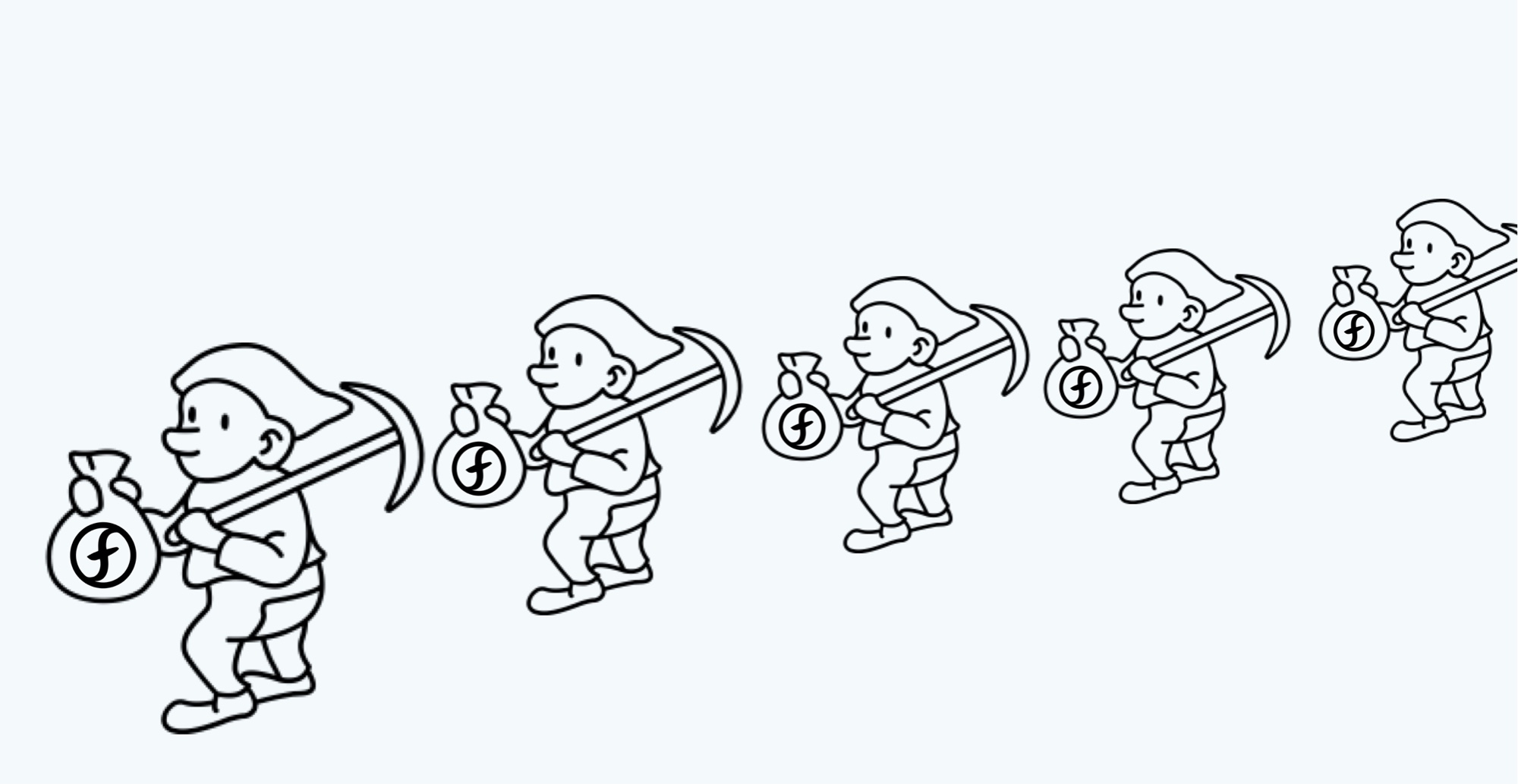Nov 10•9 min read
How Freeos Works Part 1: Overview

In this series of articles we will explain how Freeos - a Self-Governed Cooperative Income - works to generate ongoing, equitable, stable rewards for those that participate regularly.
Freeos is more than your typical blockchain currency. It is designed with characteristics that allow people to have a direct say in the running of the collective economy. This is a historic first.
Freeos is not simply a currency for trading and speculation only, but represents the value of those that participate, in addition to market forces.
Since it is important to first fully understand how Freeos works, we only cover the real-world currency uses and market forces in the final article (Part 3)
So how does Freeos work?
Freeos works in tandem with regular, cooperative activity to help ensure a stable value of the currency.
Ongoing participation earns an ongoing income.
Of course, there is much more to this system, but we'll start from the perspective of you - the Freeos participant.
The four types of activities a participant can engage in can be boiled down to: Join, Vote, Earn and Repeat.

In a vast field of crypto-weeds and identical 3-leaf clovers, occasionally a shamrock appears…
Participation is a simple process from the surface level. A snazzy User Interface will help make sure participation is smooth, informative and flowy.
But you are here to find out more about the mechanisms to make this work, right?
Great, so let's dig into what each step in the process means for participating in Freeos.
Join
Joining Freeos is not like many other cryptocurrency systems. Freeos does not require expensive mining, or buying coins early in a token sale (ICO).
Instead Freeos is designed with minimal - and in certain conditions "free" - entry costs.
These minimal expenses are structured to be easily recouped and indefinitely sustainable.
This lofty goal is accomplished through viewing what an economy might be in some very new perspectives.
Now, Freeos has two main phases.:
- the AirClaim, and
- the Governance dApp (this is where the self-governed bit comes into play).
Participants have slightly different ways to join, depending on which phase the project is in.
The AirClaim Initial Distribution kickstarts the economic engine of Freeos, and starts distributing the currency.
This even, and limited distribution limits large token holders (whales) from financially manipulating this early Freeos market.
The AirClaim is designed to last six months and provides earnings once a week. These earnings increase every week - just to keep it interesting.
An intriguing side note is that the very first participants of the AirClaim create the very first FREEOS tokens in our Community Activated Minting process.
If you come in from the start of the AirClaim and do not miss any weekly claims, you could earn a cool 10,000 FREEOS tokens! And this costs nothing but a minute of your time per week.
Which seems like a pretty sweet deal.
But what do these FREEOS tokens do?
Well, the first use case is that half of your earnings, or 5000 FREEOS, can be spent on the annual Proof-of-Burn Access Fee that is aimed to earn you around 52,000 FREEOS for a full year's worth of activity in Phase 2 of the project—the Governance dApp.
And then you can always continue to actively participate to keep those earnings ongoing indefinitely.
And, what to do with the extra 5000 FREEOS earned from the AirClaim?
Sell them, give them away, save them for a rainy day. Up to you.
You came, you claimed you conquered.
And don't worry, the Proof-of-Burn Access Fee doesn't change much once the Governance dApp goes live. The fee is governed by the participants but capped within sensible limits that ensure you only have to pay a portion of your annual earnings.
And what is really going to bake your noodle later on is realising an even cooler 3,500,000 FREEOS is allocated for each user to potentially earn over a lifetime.
We call this mechanism a Conditionally Limited Supply and this concept is pretty unique in both classic economics and crypto-economics.
More about how this Conditionally Limited Supply works in Part 3.

Conditionally Limited Supply sets a dynamic total supply that is conditional on active participants.
So you might be wondering why do we charge an ongoing Proof-of-Burn Access Fee for joining the Governance dApp?
Why not just "stake" FREEOS tokens like other projects do?
Well this is what we call Burn Valuation Dynamics This fancy title describes one of the key mechanisms that Freeos utilises to provide a price floor to the token's value.
The Burn Valuation Dynamics has a few inspirations*.
- One is Bitcoin mining and how the sunk costs of the mining hardware and electricity tends to create a price floor.
- The other is how floating, constantly minted fiat currencies also keep their own price floor— typically through taxation. We flip the script and use a carrot - not the taxation stick - instead.
- Proposed "Proof of Burn" currencies, which include deflationary protocols that decommission the tokens from circulation. This is important, as these fees are effectively decommissioned. No individual or group reveives these fees.
Besides decommissioning FREEOS tokens from circulation, these Burn Valuation Dynamics are one of the primary means to provide a price floor to the value of a FREEOS token.
Price floor?
Don't worry, we will have a whole article dedicated to how the value of the token is held steady through this and other mechanisms.
More on how the token maintains value in Part 2.
*Side Note: Interestingly, some online games like EVE Online, also allow the gamer to earn enough virtual currency to pay for their access fees, creating enough in-game income to sustain their continual participation indefinitely.
Vote
Once the Proof-of-Burn Access Fee gets paid, the new participant can now vote.
Vote on what exactly?
Vote in what we call the Democratic Fiscal Policy.
Fiscal Policies might sound dry, but don't worry - it only takes a few minutes per week. Our designers promise to make this as streamlined and exciting as possible.
And even still - you get your earnings after each weekly vote.
So what policies do you vote on? What makes up this 'Democratic Fiscal Policy'?
Ultimately, this policy can be broken down to a few key fiscal controls.
1. Vote for the inflation rate (with a max cap to limit over-inflation).
This controls the minting of new currency.
2. Vote on the Proof-of-Burn Access Fee parameters (within limits).
This range maintains the price floor but sustainably ensures that participants earn enough to pay for next year's Proof-of-Burn Access Fee. It also includes some deflationary mechanisms that can be leveraged by the participants.
3. Vote on the allotment of the Democratic Partnership Incentives (addressed in Part 3)
This brings the FREEOS system active partners incentivised to spread the word and onboard new participants —all while doing good.
4. Vote on whether part of the reserve pool should be put up for sale.
This is a great tool to help keep the value of the FREEOS token when the greater economy is dropping. Intended to be used periodically and includes deflationary mechanisms.
Each of these helps hold up the value of the FREEOS token and provides the means for responsible and effective stewardship of the economy by the participants. More on how the user interface gives contextual hints based on community sentiment in Part 3.
All using the wonders of blockchain combined with direct democracy.
Who would have thought that a community could steer their own economy towards success?
Well, we did. We thought this just might be crazy enough to work. After all, we believe in the power of people to succeed when given the responsibility and the right conditions.
And there is an entire history of large groups steering some really complex systems and processes towards success. This process is called "wisdom-of-the-crowd".
Read up on it if you have a chance. It is truly fascinating how uncanny the wisdom can be derived from large groups working in unison - especially when incentivised to do so.
Earn
This is the fun part. Once you vote, you earn.
We say "earn" because Freeos isn't just a Universal Basic Income. Earning your allotment of FREEOS tokens includes some basic conditions and responsibilities after all.
This is why we call it a Self-Governed Cooperative Income. It alludes to some of the key differences Freeos possesses compared to a "classic" Universal Basic Income.
When you miss a weekly vote, you simply don't receive your earnings. You earn it for your participation. It is not merely a "Hand-Out".
It is a "Hand-In-Hand-Out". Or, affectionately known as "HIHO."
So with that in mind, "Hi-Ho, Hi-Ho, it's off to work we go…"

Built using the wonders of distributed dwarfchain technology.
Working hand-in-hand to keep the fires stoked and the engines of this Self-Governed Cooperative Income moving forward.
Repeat
After you earn, it will be time to vote for the next week's Democratic Fiscal Policy and earn yet again.
But the great thing is that a few months of voting earns enough to pay the Proof-of-Burn Access Fee. Play your cards wisely (we make it easy) and you can keep this access fee going every year through the FREEOS you are earning.
So just try not to go into an uninhibited FREEOS-fueled spending spree (in the real-world markets envisioned and explained in Part 3)
3 Main Use Cases
By participating in this process the participants create the dynamics of a new economy.
But for what purpose?
Essentially this can be broken down into three clear use cases.
1. As an income - that is designed to be managed by the community towards price stability.
More on how the price of FREEOS is maintained in Part 2
2. As a currency for trading, markets, payments etc.
Local markets are targeted with Vouchers, designed to incentivise local groups of informed stewards of Freeos and merchants that accept the currency. More on this in Part 3
3. As a store of value.
Once FREEOS becomes a stable currency - one that is stewarded by the participants to a useful value based on purchasing power - then it becomes possible for savings to be safely held.
Conclusion
This concludes Part 1 where we ran through some of the high-level concepts behind how the Freeos system works to earn participants with a democratically issued income.
Curious to find out how deep the rabbit hole goes?
Dive into the links below to additional articles that dive deeper into the mechanisms that make Freeos the historic new type of economy it is intended to be.
Part 2 dives deeper into the mechanisms designed to help hold the token's value. After all, maintaining a strong stable value helps real people with their real-world expenses and purchases.
Part 3 dives deeper into some of the interesting supporting mechanisms that help the system sustainably grow and respond to the real world.
And if you'd like to ask questions directly, Join our Discord Channel.
